
I flipping through some of my indicator charts that I haven't looked at for at least a month. The chart that caught my eye today was our Rydex Ratio chart. The Rydex Asset Ratio makes it possible for us to analyze sentiment based upon what investors are actually doing with real money. We do this by calculating a daily bear/bull asset ratio and monitoring the relationship between assets in the two types of funds. All Rydex mutual funds were renamed after the Rydex company was purchased by Guggenheim Investments, but we continue to use the legacy "Rydex" name for the ratios.
What struck me was how accurately Rydex Ratio overbought conditions generally appear before market pullbacks or declines. I have marked the cardinal tops in the market. With the exception of late 2019's overbought peak, overbought conditions preceded the declines. We currently have a Rydex Ratio with the highest reading in two years! Food for thought as the SPY reenters its trading channel.
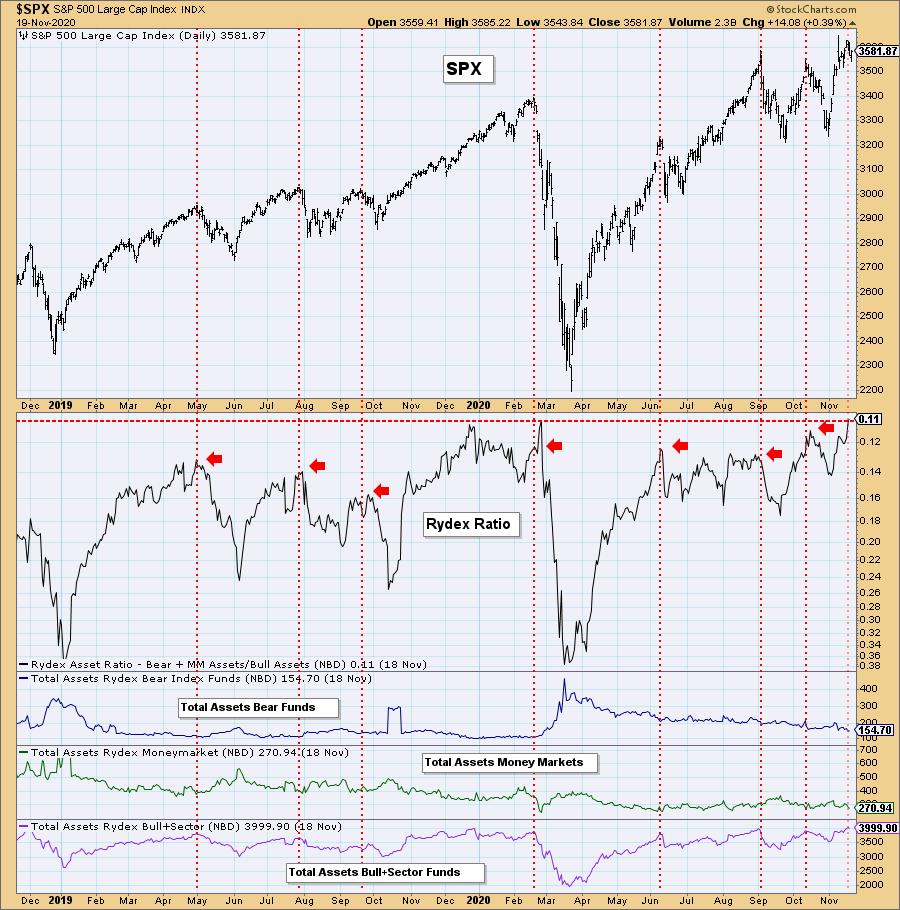
The DecisionPoint Alert Weekly Wrap presents an end-of-week assessment of the trend and condition of the Stock Market, the U.S. Dollar, Gold, Crude Oil, and Bonds. The DecisionPoint Alert daily report (Monday through Thursday) is abbreviated and gives updates on the Weekly Wrap assessments.
Watch the latest episode of DecisionPoint on StockCharts TV's YouTube channel here!
MAJOR MARKET INDEXES
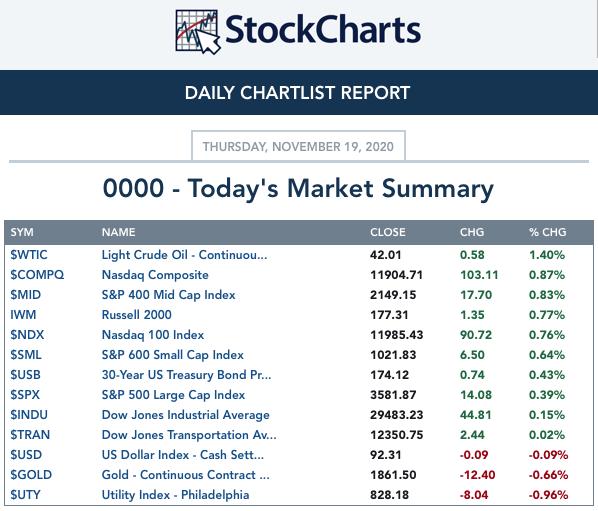
SECTORS
Each S&P 500 Index component stock is assigned to one, and only one, of 11 major sectors. This is a snapshot of the Intermediate-Term (Silver Cross) and Long-Term (Golden Cross) Trend Model signal status for those sectors.
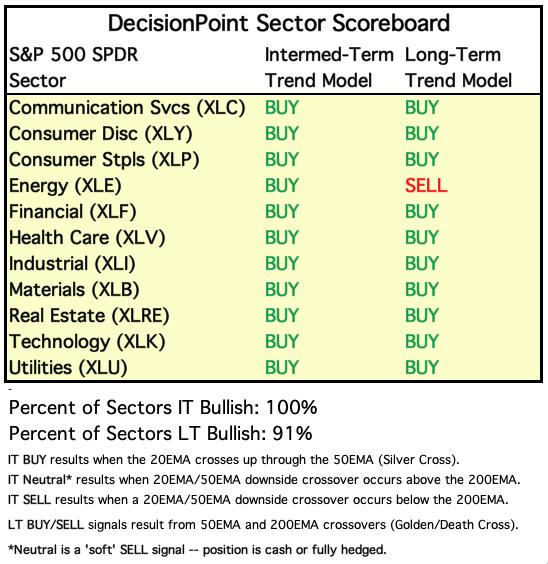
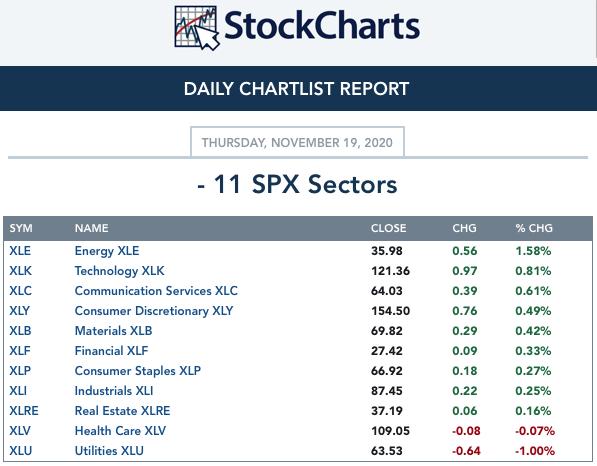
CLICK HERE for Carl's annotated Sector charts.
THE MARKET (S&P 500)
IT Trend Model: BUY as of 5/8/2020
LT Trend Model: BUY as of 6/8/2020
SPY Daily Chart: The October top barely held up as support today. Despite a positive close we still have a short-term declining trend. It could be a short-term flag coming off the October low, but given overbought indicators and now a PMO that is topping, I wouldn't bet on it. Volume was light on a positive trading day which suggests lower participation.
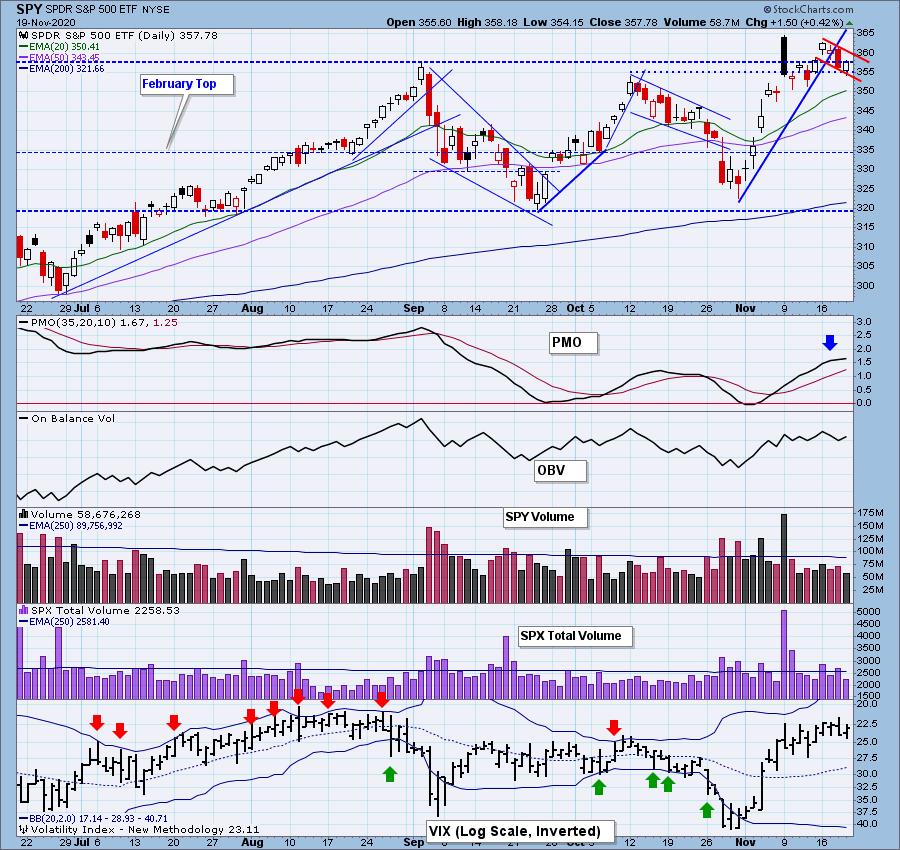
The RSI does remain positive, but price has dropped back into the trading range. You know this does have the look of a bearish pig's ear pattern. That's a trading range punctuated by a breakout from the range. Typically it ends with price dropping back within the trading range and testing the lows.
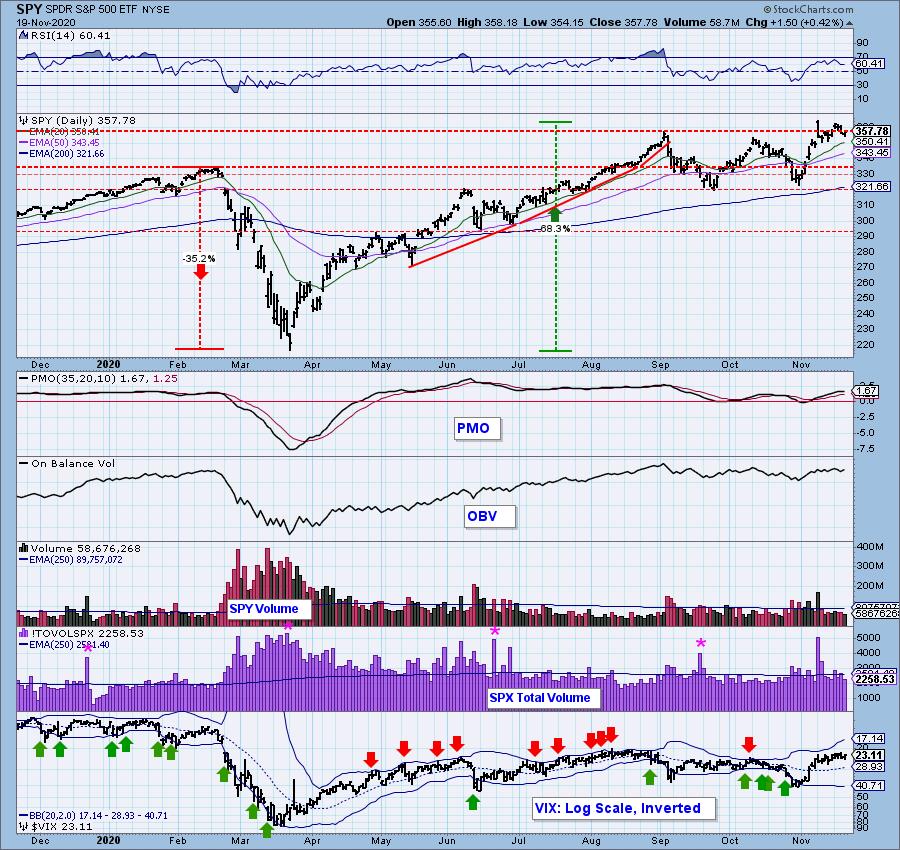

It's Free!
***Click here to register for this recurring free DecisionPoint Trading Room on Mondays at Noon ET!***
Did you miss the 11/16 trading room? Here is a link to the recording -- access code: =8STr92*
For best results, copy and paste the access code to avoid typos.
Participation: The following chart uses different methodologies for objectively showing the depth and trend of participation for intermediate- and long-term time frames.
- The Silver Cross Index (SCI) shows the percentage of SPX stocks on IT Trend Model BUY signals (20-EMA > 50-EMA).
- The Golden Cross Index (GCI) shows the percentage of SPX stocks on LT Trend Model BUY signals (50-EMA > 200-EMA).
- The Bullish Percent Index (BPI) shows the percentage of SPX stocks on Point & Figure BUY signals.
The BPI barely avoided a negative crossover today. Although the SCI and GCI are still rising, they are both beginning to decelerate.
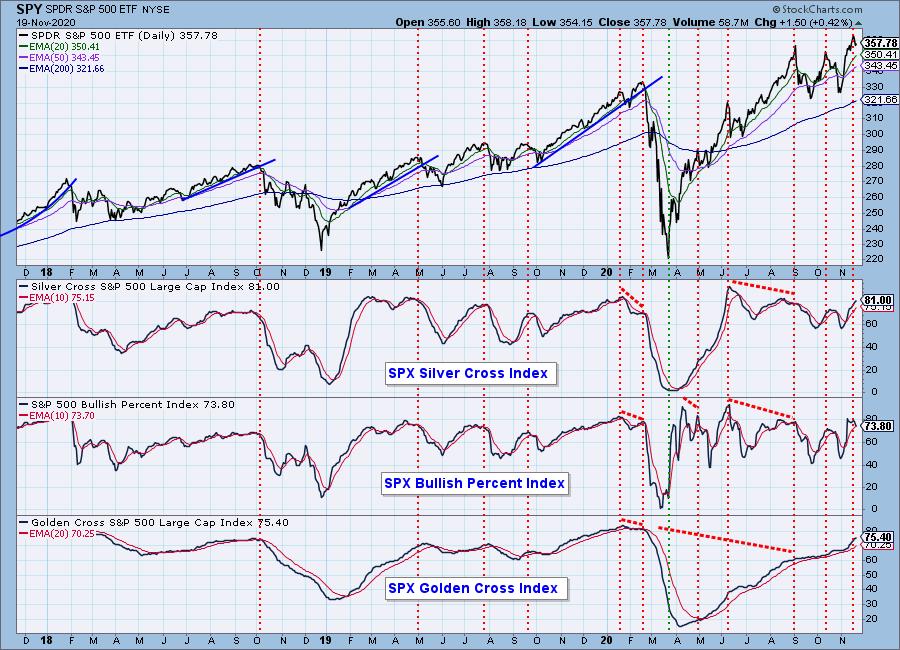
%Stocks > 20/50/200-EMAs remain overbought and are topping.
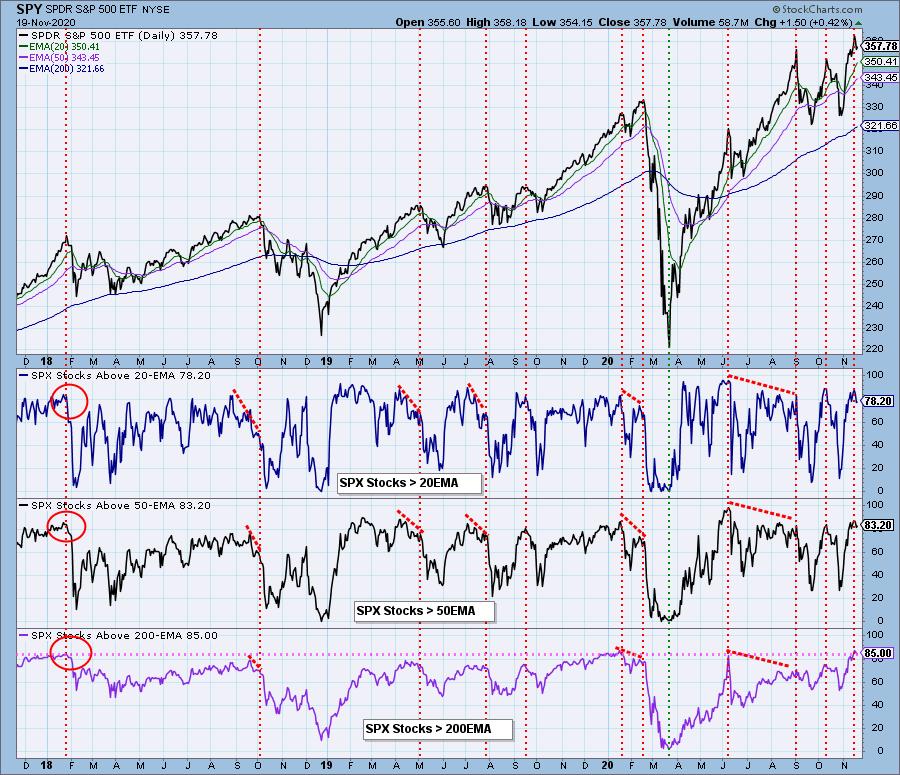
Climactic Market Indicators: No climactic readings to report today. I'll simply note that the VIX readings have flattened. A VIX above its moving average on an inverted scale gives us a bullish bias in the very short term, but if the VIX turns over that implies a short-term decline is on the way.
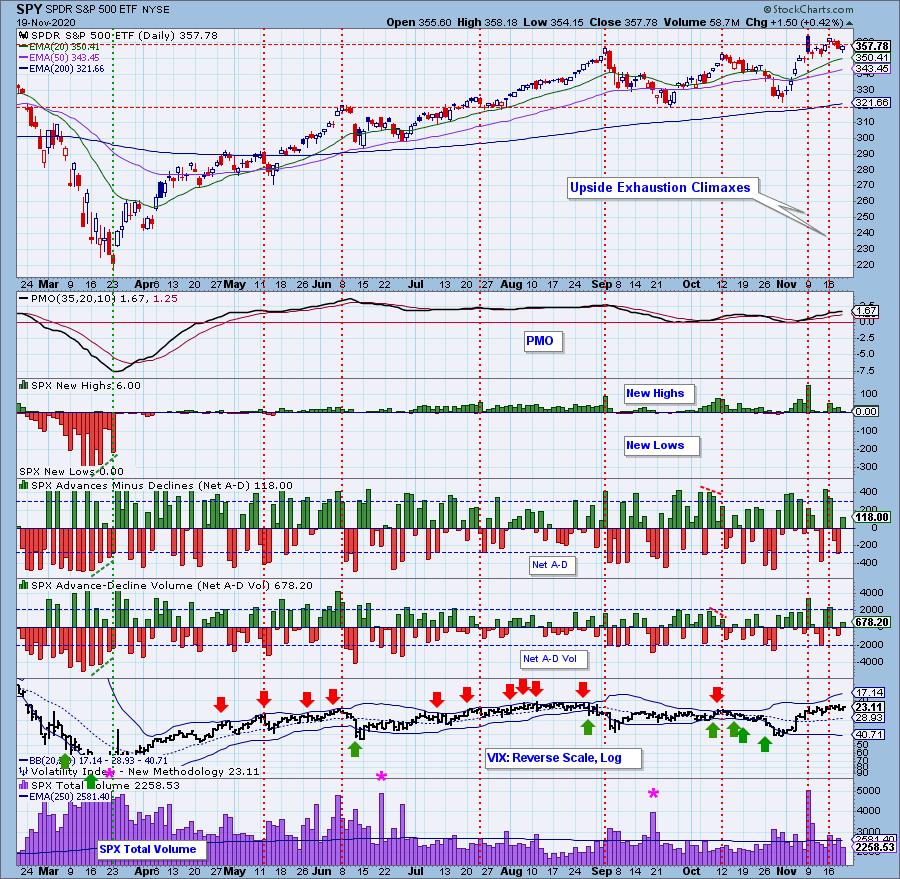
Short-Term Market Indicators: The short-term market trend is UP and the condition is NEUTRAL.
We have negative divergences on all of our short-term indicators. The STOs popped higher today which is bullish, but I'm concerned its marking a short-term exhaustion rather than initiation.
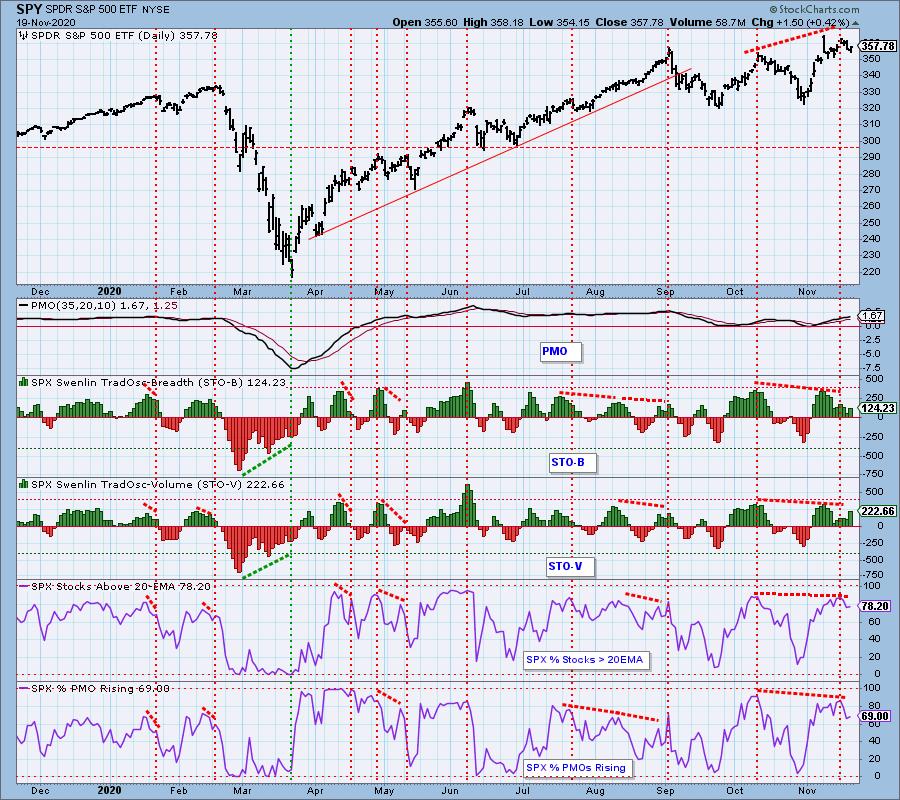
Intermediate-Term Market Indicators: The intermediate-term market trend is UP and the condition is OVERBOUGHT. The market bias is BULLISH.
The divergence between the ITBM and ITVM remains as the former continued to decline and the latter continued to rise. This means that the negative divergence on the ITVM isn't official. We don't have a second ITVM top yet. Currently it is showing a negative divergence.
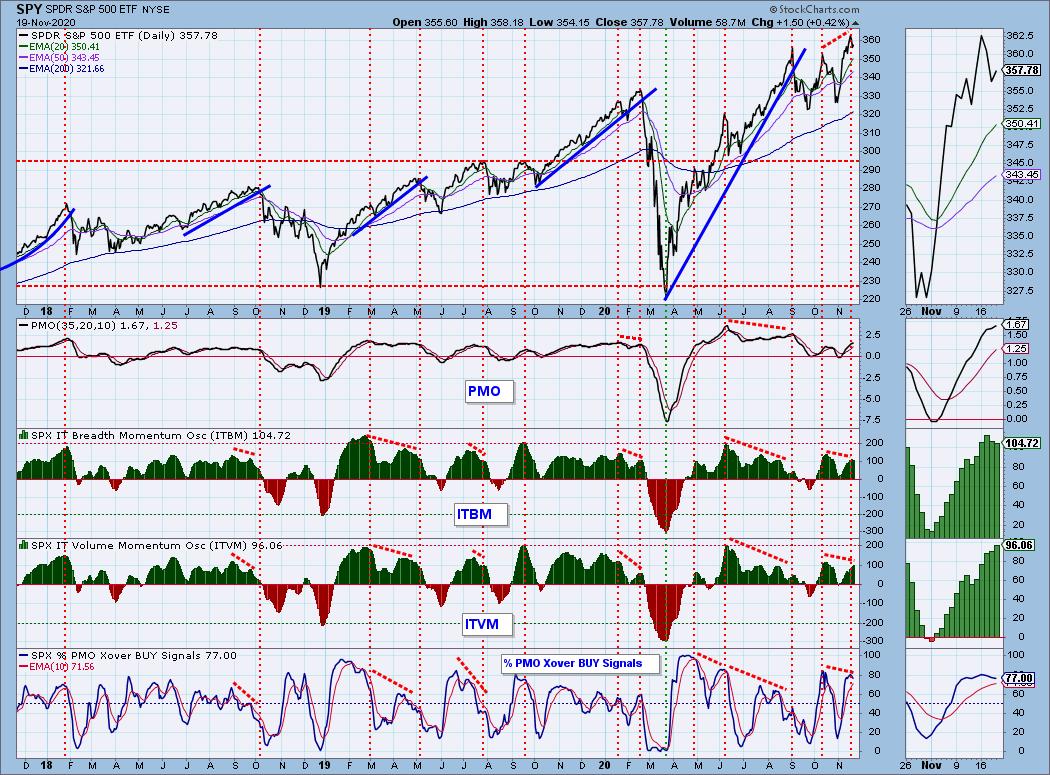
CONCLUSION: Despite the market closing higher, volume was below average and price found its way back into the large trading range. Indicators remain overbought and negative divergences are visible in the short and intermediate terms. Momentum is beginning to peak which suggests to me we will begin inching our way down toward the bottom of the range. The STOs did pop higher today so that certainly softens the blow. It suggests we will see a decline but not a correction. Don't forget that overbought Rydex Ratio either!
Have you subscribed the DecisionPoint Diamonds yet? DP does the work for you by providing handpicked stocks/ETFs from exclusive DP scans! Add it with a discount! Contact support@decisionpoint.com for more information!
INTEREST RATES
This chart is included so we can monitor rate inversions. In normal circumstances the longer money is borrowed the higher the interest rate that must be paid. When rates are inverted, the reverse is true.
Yields are in a short-term declining trend which should continue to help Bond prices.
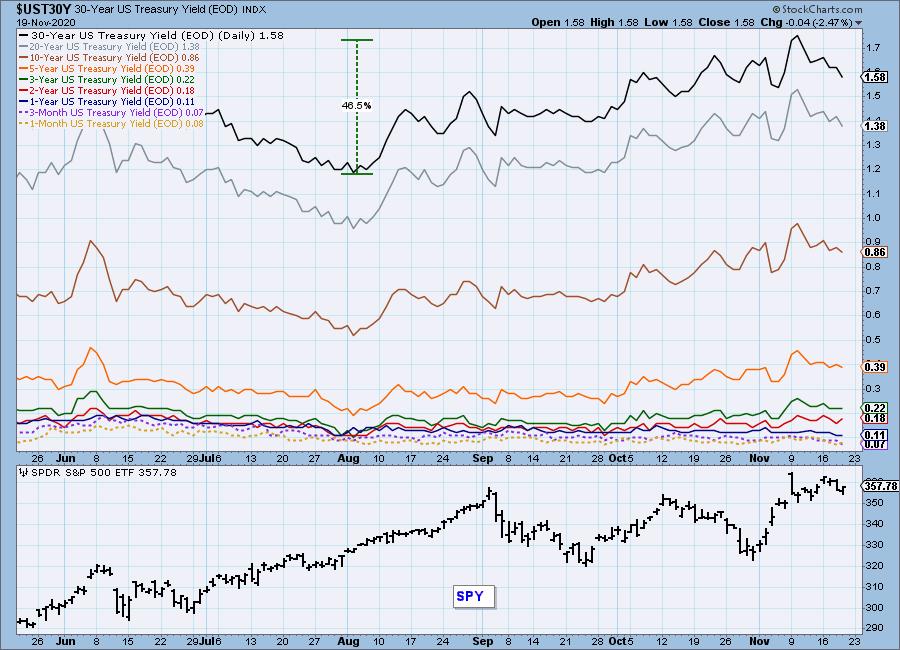
DOLLAR (UUP)
IT Trend Model: NEUTRAL as of 5/28/2020
LT Trend Model: SELL as of 7/10/2020
UUP Daily Chart: Yesterday's comments still apply:
"As expected, UUP is headed down to test support. The PMO is headed lower after topping twice at the zero line. The RSI is negative and not oversold so I'm expecting price to hit $24.75 before rising again."
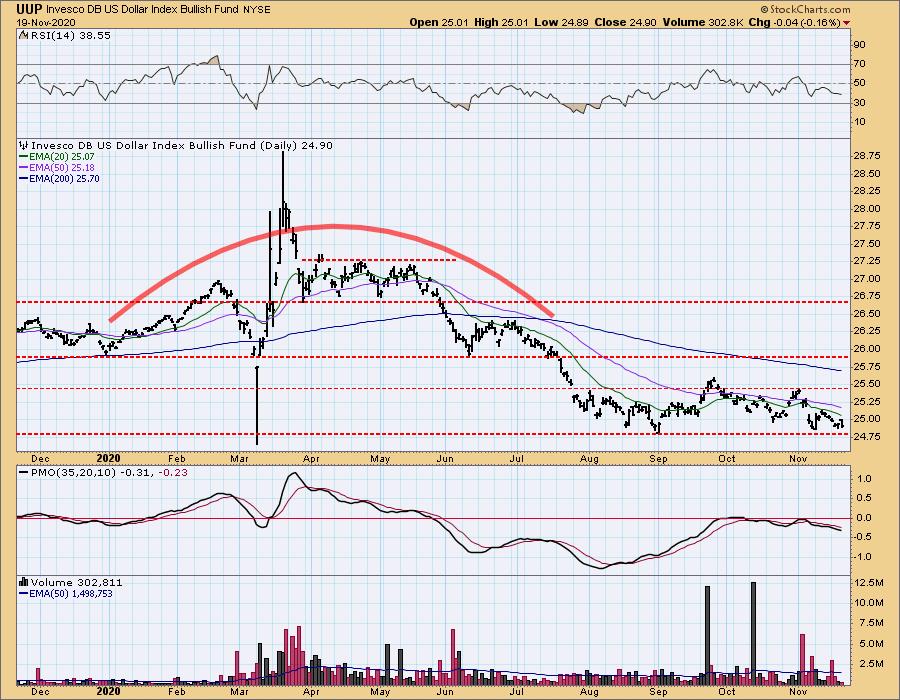
GOLD
IT Trend Model: NEUTRAL as of 10/13/2020
LT Trend Model: BUY as of 1/8/2019
GOLD Daily Chart: Gold continues to hold support and meander sideways. It failed to overcome resistance at the 20/50-EMAs and turned down before breaking out of the declining trend. Good news is that discounts are getting very high and typically that is a precursor to higher prices. The RSI is negative and getting worse and the PMO continues to decline. I would look for Gold to hold this support level, but with a negative PMO and RSI, it's not time for a breakout.
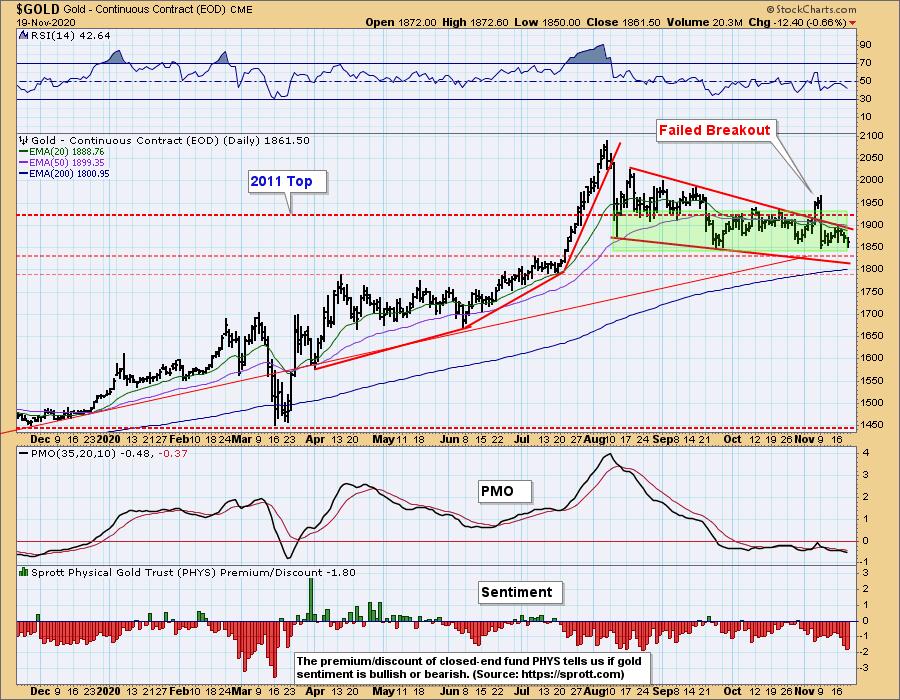
GOLD MINERS Golden and Silver Cross Indexes: Miners dropped below the 200-EMA and lost support at the October low. I have been bullish on this sector, but the loss of this support suggests prices will move even lower. The %Stocks above their 200-EMA is near-term oversold, but until I see it turn back up, I am bearish on Miners.
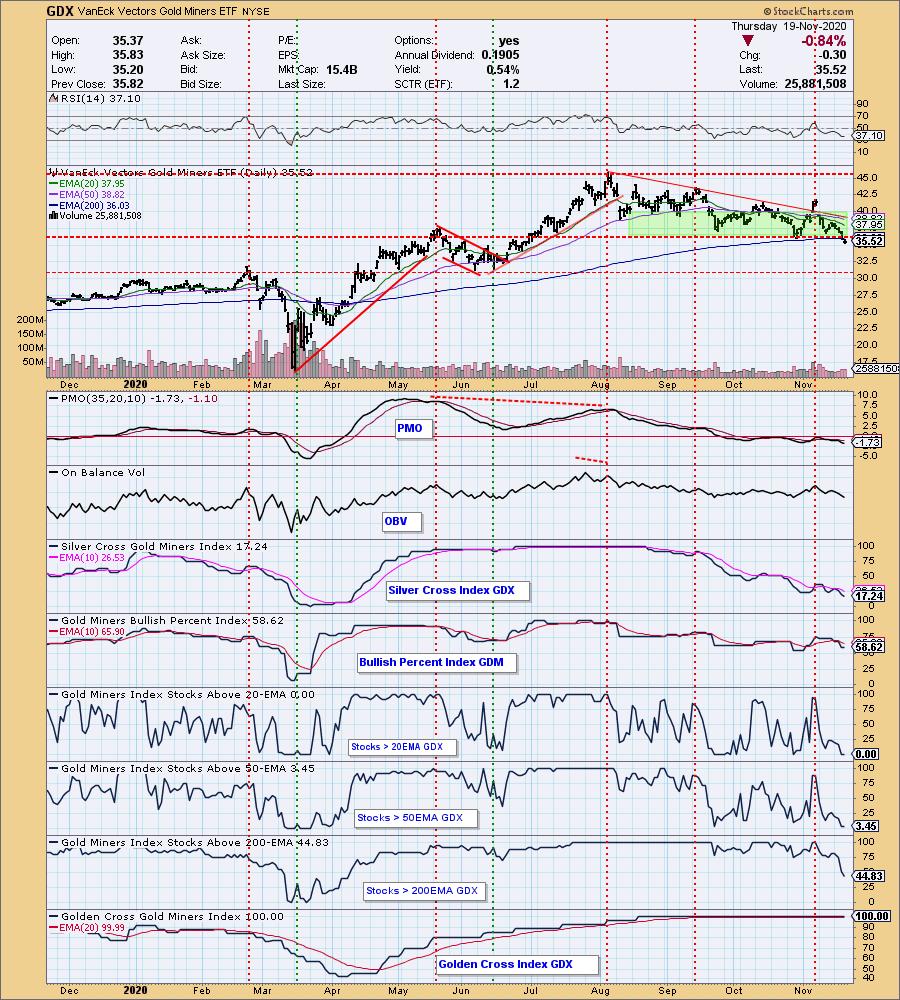
CRUDE OIL (USO)
IT Trend Model: SELL as of 9/8/2020
LT Trend Model: SELL as of 2/3/2020
USO Daily Chart: Yesterday's comments still apply:
"The 20-EMA didn't cross above the 50-EMA today, so we have to wait at least one more day for that "silver cross". Price is continuing to digest the rally off the October low. The RSI remains positive and the PMO is now positive and rising. I am looking for USO to continue higher and test the $31 level."
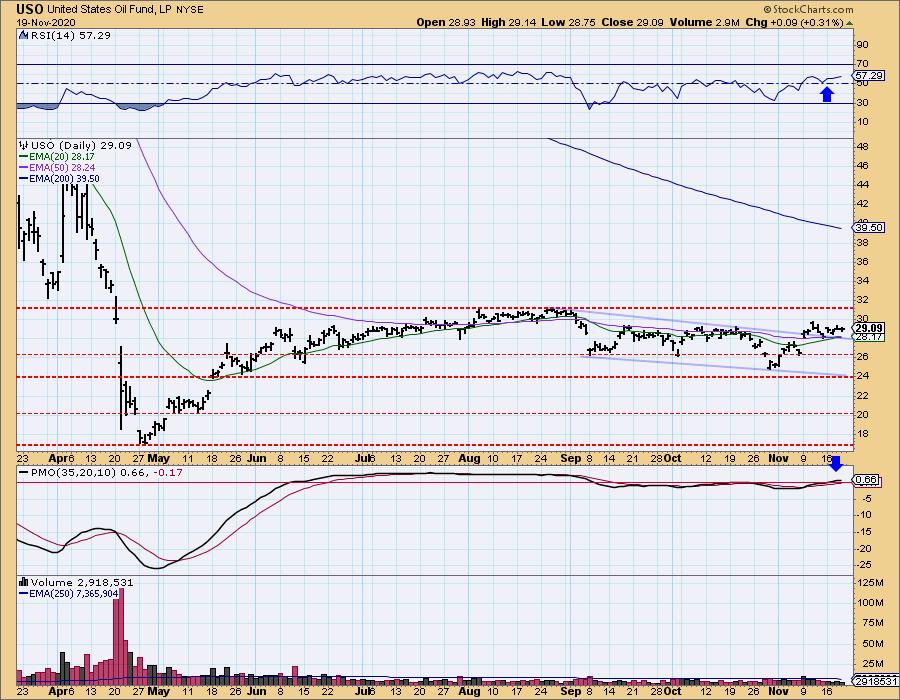
BONDS (TLT)
IT Trend Model: NEUTRAL as of 8/27/2020
LT Trend Model: BUY as of 1/2/2019
TLT Daily Chart: Price is now testing the top of the declining trend channel. I noted above on the short-term Yields chart that longer-term yields are now in a short-term declining trend for this last half of November. That is positive for Bonds which just had the RSI move into positive territory and the PMO clicked a crossover BUY signal yesterday. I expect a breakout soon.
Full Disclosure: I own TLT.
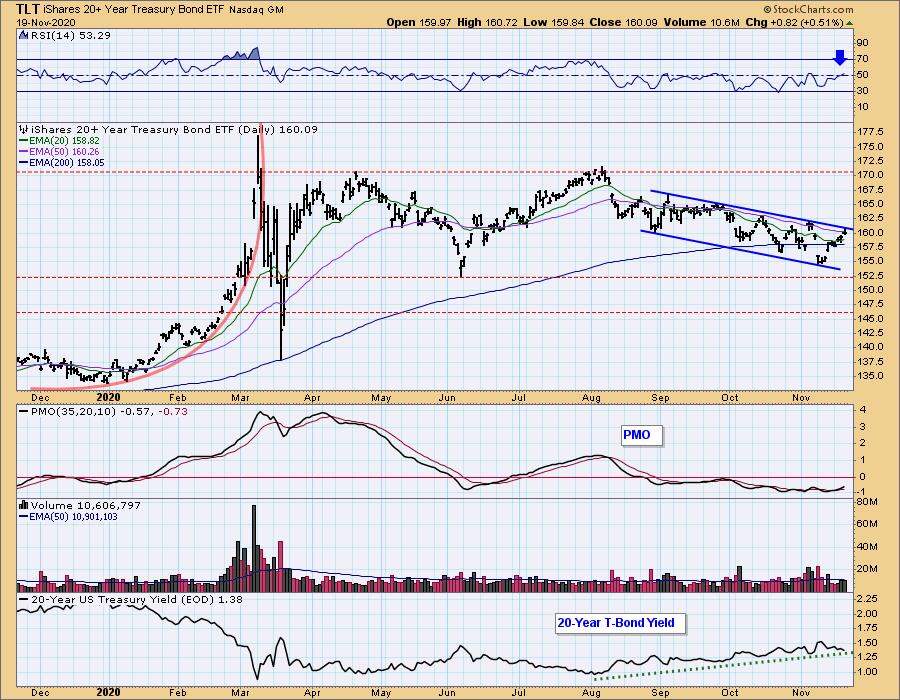
Technical Analysis is a windsock, not a crystal ball.
Happy Charting! - Erin
Disclaimer: This blog is for educational purposes only and should not be construed as financial advice. The ideas and strategies should never be used without first assessing your own personal and financial situation, or without consulting a financial professional. Any opinions expressed herein are solely those of the author, and do not in any way represent the views or opinions of any other person or entity.
NOTE: The signal status reported herein is based upon mechanical trading model signals, specifically, the DecisionPoint Trend Model. They define the implied bias of the price index based upon moving average relationships, but they do not necessarily call for a specific action. They are information flags that should prompt chart review. Further, they do not call for continuous buying or selling during the life of the signal. For example, a BUY signal will probably (but not necessarily) return the best results if action is taken soon after the signal is generated. Additional opportunities for buying may be found as price zigzags higher, but the trader must look for optimum entry points. Conversely, exit points to preserve gains (or minimize losses) may be evident before the model mechanically closes the signal.
Helpful DecisionPoint Links:
DecisionPoint Alert Chart List
DecisionPoint Golden Cross/Silver Cross Index Chart List
DecisionPoint Sector Chart List
Price Momentum Oscillator (PMO)
Swenlin Trading Oscillators (STO-B and STO-V)